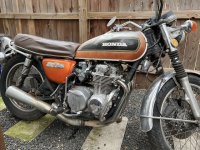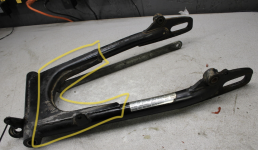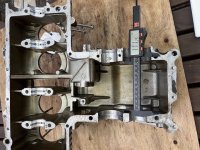mazzola
1 mW
For my first build, I've started converting this 1975 Honda CB550 with the intention of turning it into a city commuter that preserves the original aesthetics of the motorcycle as much as possible.

There's a pretty big restoration part of this project (e.g. painting, fixing bearings, leaky forks, front break lines) but this thread will focus on the new electric drivetrain unless folks are interested in my amateur restoration process as well.
I'll be using this bike for cruising around town which means typical speeds of 35mph (56kph) and low range, 15mi. (25km) or so. Sometimes I'll be riding at 35mph with a passenger or cargo on the bike, bringing to total load to 240lbs (110kg). The other need I have is to occasionally commute outside of the city about 25mi. (40km) from one charging station to another with some stretches at 45mph (73kph). This is what I was thinking to use as my "worst case" scenario to design against.
My dream is to keep as much of the aesthetics of the old bike as possible. Since it doesn't have any fairings, this means hiding or blending in a lot of the new components. At the end of the conversion, I want the bike to look as close to stock as possible. Something like this:

I know this is going to mean a lot of tradeoffs and a lot more work when picking my components but I love the looks of these old bikes too much . Since my performance needs are not too extreme, I think this should be possible.
. Since my performance needs are not too extreme, I think this should be possible.
I'll follow up with more detailed posts about how I'm thinking about the motor, batteries, and controller. But for now I'm proposing to use:
* Grin All-Axle front hub motor, fast winding with Statorade, installed in the rear wheel
* 72v, 2.1kwh (20s7p Molicel 21700 P42As) enclosed by the old engine case
* V6 Phaserunner, programmed to 96A phase current, 96A battery current
Let me know what y'all think!

There's a pretty big restoration part of this project (e.g. painting, fixing bearings, leaky forks, front break lines) but this thread will focus on the new electric drivetrain unless folks are interested in my amateur restoration process as well.
I'll be using this bike for cruising around town which means typical speeds of 35mph (56kph) and low range, 15mi. (25km) or so. Sometimes I'll be riding at 35mph with a passenger or cargo on the bike, bringing to total load to 240lbs (110kg). The other need I have is to occasionally commute outside of the city about 25mi. (40km) from one charging station to another with some stretches at 45mph (73kph). This is what I was thinking to use as my "worst case" scenario to design against.
My dream is to keep as much of the aesthetics of the old bike as possible. Since it doesn't have any fairings, this means hiding or blending in a lot of the new components. At the end of the conversion, I want the bike to look as close to stock as possible. Something like this:

I know this is going to mean a lot of tradeoffs and a lot more work when picking my components but I love the looks of these old bikes too much
I'll follow up with more detailed posts about how I'm thinking about the motor, batteries, and controller. But for now I'm proposing to use:
* Grin All-Axle front hub motor, fast winding with Statorade, installed in the rear wheel
* 72v, 2.1kwh (20s7p Molicel 21700 P42As) enclosed by the old engine case
* V6 Phaserunner, programmed to 96A phase current, 96A battery current
Let me know what y'all think!




